超简单的统计结果可视化工具,推荐~~
小编在查阅资料时发现一个宝藏可视化包-R-see,该包可以将数据的统计计算结果、模型参数、预测结果以及性能估算等使用合理的可视化方式展现,帮助使用者利用可视化来获得更多信息、可交流和全面的科学报告。话不多说,接下来就让小编带大家感受下这个包的魅力(其中可能涉及统计分析知识,后期和Python一起讲解,本期只关注其可视化部分)
R-see包工作原理
得益于easystats项目下的多个优秀统计分析包(以后会出专题详细介绍)的强大功能,R-see包可使用plot() 方法将这些包所构建的对象(如参数表、基于模型的预测、性能诊断测试、相关矩阵等)可视化出来。简单来讲,就是easystats项目中的其他包负责各种统计模型的数据结果计算,see包作为对整个easystats 生态系统的可视化支持。当然,可视化结果还是可以和ggplot2其他图层结合使用的。更多详细介绍可参考:R-see包介绍[1]。接下里简单介绍下R-see包基于各种easystats项目中其他包的可视化效果。
R-see包可视化展示
基于bayestestR包
「样例一」:Highest Density Interval (HDI)
library(bayestestR)
library(insight)
library(see)
library(rstanarm)
library(ggplot2)
library(ggtext)
library(hrbrthemes)
#可视化绘制
set.seed(123)
# model with fixed effects only
model <- rstanarm::stan_glm(Sepal.Length ~ Petal.Width * Species, data = iris, refresh = 0)
# model with fixed and random effects as well as zero-inflation component
model2 <- insight::download_model("brms_zi_3")
#样例一:Highest Density Interval (HDI)
result <- hdi(model, ci = c(0.5, 0.75, 0.89, 0.95))
plot(result) +
scale_fill_flat() +
labs(x="",y="",
title = "Example of <span style='color:#D20F26'>bayestestR::Highest Density Interval function</span>",
subtitle = "processed charts with <span style='color:#1A73E8'>see::plot()</span>",
caption = "Visualization by <span style='color:#0057FF'>DataCharm</span>") +
hrbrthemes::theme_ipsum(base_family = "Roboto Condensed") +
theme(
plot.title = element_markdown(hjust = 0.5,vjust = .5,color = "black",
size = 20, margin = margin(t = 1, b = 12)),
plot.subtitle = element_markdown(hjust = 0,vjust = .5,size=15),
plot.caption = element_markdown(face = 'bold',size = 12))
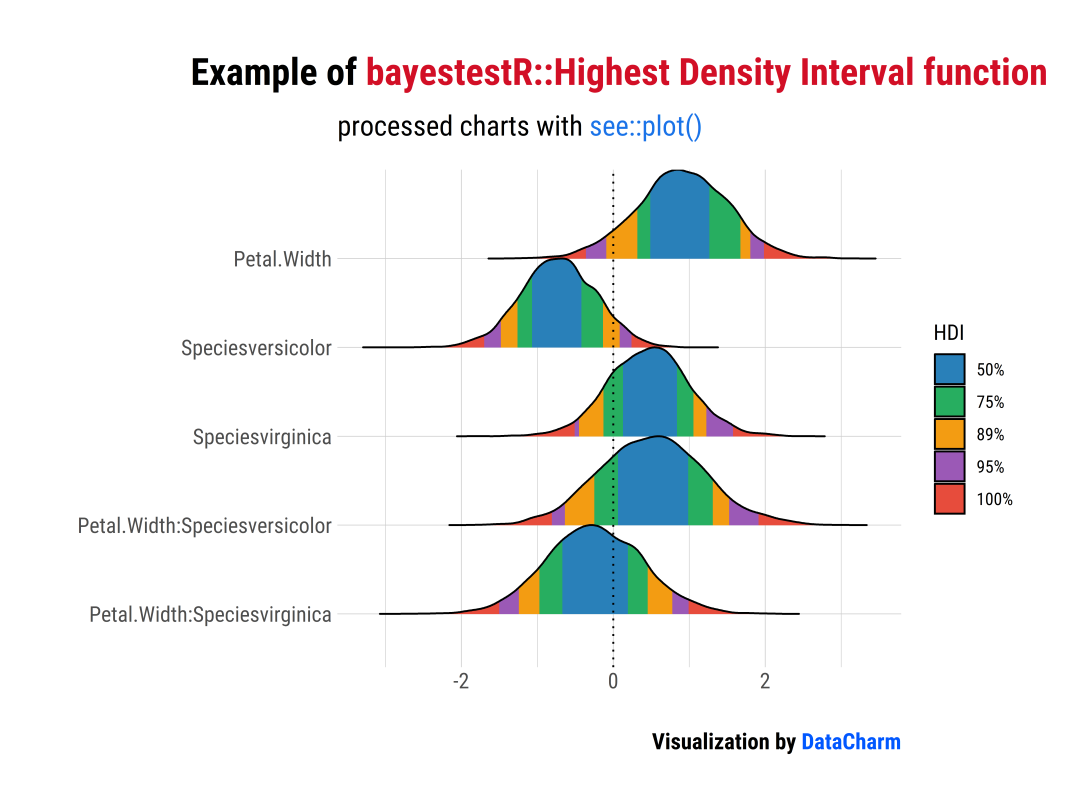
「样例二」:Support Interval
result <- si(model)
plot(result, support_only = TRUE) +
scale_color_metro(palette = "ice") +
scale_fill_metro(palette = "ice") +
labs(x="",y="",
title = "Example of <span style='color:#D20F26'>bayestestR::Support Interval function</span>",
subtitle = "processed charts with <span style='color:#1A73E8'>see::plot()</span>",
caption = "Visualization by <span style='color:#0057FF'>DataCharm</span>") +
hrbrthemes::theme_ipsum(base_family = "Roboto Condensed") +
theme(
plot.title = element_markdown(hjust = 0.5,vjust = .5,color = "black",
size = 20, margin = margin(t = 1, b = 12)),
plot.subtitle = element_markdown(hjust = 0,vjust = .5,size=15),
plot.caption = element_markdown(face = 'bold',size = 12))

更多其他基于bayestestR绘制统计结果可视化结果可参考:bayestestR see::plot()[2]
基于effectsize包
「样例」:
library(effectsize)
data(mtcars)
data(iris)
t_to_d(t = c(1, -1.3, -3, 2.3), df_error = c(40, 35, 40, 85)) %>%
equivalence_test(range = 1) %>%
plot() +
labs(x="",y="",
title = "Example of <span style='color:#D20F26'>effectsize::equivalence_test function</span>",
subtitle = "processed charts with <span style='color:#1A73E8'>see::plot()</span>",
caption = "Visualization by <span style='color:#0057FF'>DataCharm</span>") +
hrbrthemes::theme_ipsum(base_family = "Roboto Condensed") +
theme(
plot.title = element_markdown(hjust = 0.5,vjust = .5,color = "black",
size = 20, margin = margin(t = 1, b = 12)),
plot.subtitle = element_markdown(hjust = 0,vjust = .5,size=15),
plot.caption = element_markdown(face = 'bold',size = 12))

更多其他基于effectsize绘制统计结果可视化结果可参考:effectsize see::plot()[3]
基于modelbased包
「样例」:
library(modelbased)
model <- stan_glm(Sepal.Width ~ Species, data = iris, refresh = 0)
contrasts <- estimate_contrasts(model)
means <- estimate_means(model)
plot(contrasts, means) +
labs(x="",y="",
title = "Example of <span style='color:#D20F26'>modelbased::estimate_means function</span>",
subtitle = "processed charts with <span style='color:#1A73E8'>see::plot()</span>",
caption = "Visualization by <span style='color:#0057FF'>DataCharm</span>") +
hrbrthemes::theme_ipsum(base_family = "Roboto Condensed") +
theme(
plot.title = element_markdown(hjust = 0.5,vjust = .5,color = "black",
size = 20, margin = margin(t = 1, b = 12)),
plot.subtitle = element_markdown(hjust = 0,vjust = .5,size=15),
plot.caption = element_markdown(face = 'bold',size = 12))

更多其他基于modelbased绘制统计结果可视化结果可参考:modelbased see::plot()[4]
基于parameters包
「样例一」:Comparison of Models
library(parameters)
data(iris)
# shorter variable name
iris$Length <- iris$Petal.Length
lm1 <- lm(Sepal.Length ~ Species, data = iris)
lm2 <- lm(Sepal.Length ~ Species + Length, data = iris)
lm3 <- lm(Sepal.Length ~ Species * Length, data = iris)
result <- compare_parameters(lm1, lm2, lm3)
plot(result) +
labs(x="",y="",
title = "Example of <span style='color:#D20F26'>parameters::compare_parameters function</span>",
subtitle = "processed charts with <span style='color:#1A73E8'>see::plot()</span>",
caption = "Visualization by <span style='color:#0057FF'>DataCharm</span>") +
hrbrthemes::theme_ipsum(base_family = "Roboto Condensed") +
theme(
plot.title = element_markdown(hjust = 0.5,vjust = .5,color = "black",
size = 20, margin = margin(t = 1, b = 12)),
plot.subtitle = element_markdown(hjust = 0,vjust = .5,size=15),
plot.caption = element_markdown(face = 'bold',size = 12))
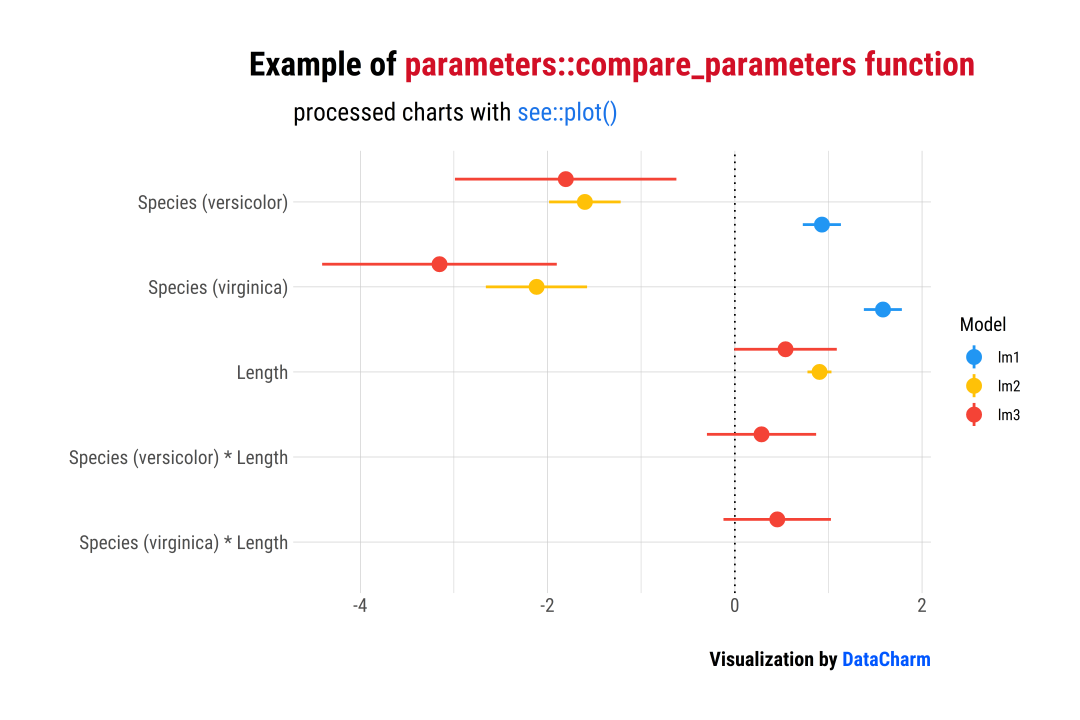
「样例二」:Cluster Analysis
data(iris)
result <- cluster_analysis(iris[, 1:4], n_clusters = 3)
plot(result) +
scale_fill_material_d(palette = "ice") +
labs(x="",y="",
title = "Example of <span style='color:#D20F26'>parameters::cluster_analysis function</span>",
subtitle = "processed charts with <span style='color:#1A73E8'>see::plot()</span>",
caption = "Visualization by <span style='color:#0057FF'>DataCharm</span>") +
hrbrthemes::theme_ipsum(base_family = "Roboto Condensed") +
theme(
plot.title = element_markdown(hjust = 0.5,vjust = .5,color = "black",
size = 20, margin = margin(t = 1, b = 12)),
plot.subtitle = element_markdown(hjust = 0,vjust = .5,size=15),
plot.caption = element_markdown(face = 'bold',size = 12))
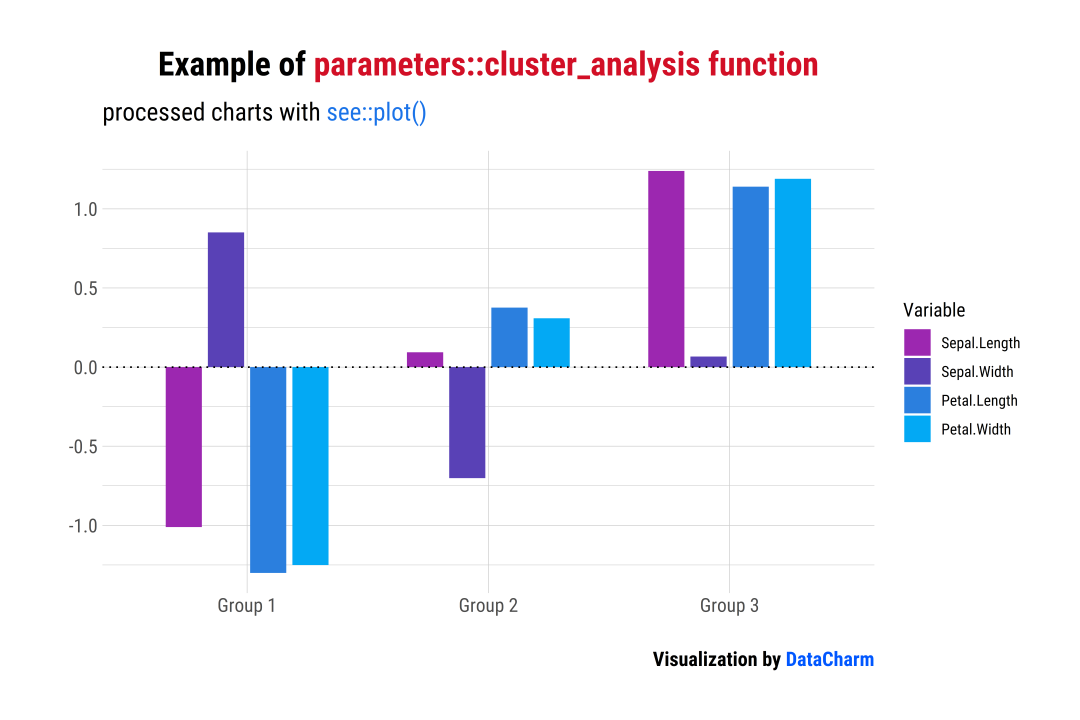
更多其他基于parameters绘制统计结果可视化结果可参考:parameters see::plot()[5]
基于performance包
「样例」:Check for Normal Distributed Random Effects
library(performance)
library(lme4)
model <- lmer(Reaction ~ Days + (Days | Subject), sleepstudy)
result <- check_normality(model, effects = "random")
plot(result)

「样例二」:Check for Homogeneity
model <- lm(len ~ supp + dose, data = ToothGrowth)
result <- check_homogeneity(model)
plot(result) +
labs(x="",y="",
title = "Example of <span style='color:#D20F26'>performance::check_homogeneity function</span>",
subtitle = "processed charts with <span style='color:#1A73E8'>see::plot()</span>",
caption = "Visualization by <span style='color:#0057FF'>DataCharm</span>") +
hrbrthemes::theme_ipsum(base_family = "Roboto Condensed") +
theme(
plot.title = element_markdown(hjust = 0.5,vjust = .5,color = "black",
size = 20, margin = margin(t = 1, b = 12)),
plot.subtitle = element_markdown(hjust = 0,vjust = .5,size=15),
plot.caption = element_markdown(face = 'bold',size = 12))

更多其他基于performance绘制统计结果可视化结果可参考:performance see::plot()[6]
多图绘制(Multiple plots)
R-see包还提供plots() 函数用于绘制多个可视化图,如下:
p1 <- ggplot(iris, aes(x = Species, y = Sepal.Length, fill = Species)) +
geom_boxplot() +
theme_modern(axis.text.angle = 45) +
scale_fill_material_d()
p2 <- ggplot(iris, aes(x = Species, y = Sepal.Length, fill = Species)) +
geom_violin() +
theme_modern(axis.text.angle = 45) +
scale_fill_material_d(palette = "ice")
p3 <- ggplot(iris, aes(x = Petal.Length, y = Petal.Width, color = Sepal.Length)) +
geom_point2() +
theme_modern() +
scale_color_material_c(palette = "rainbow")
plots(p1, p2, p3,
n_columns = 2,
tags = paste("Fig. ", 1:3))
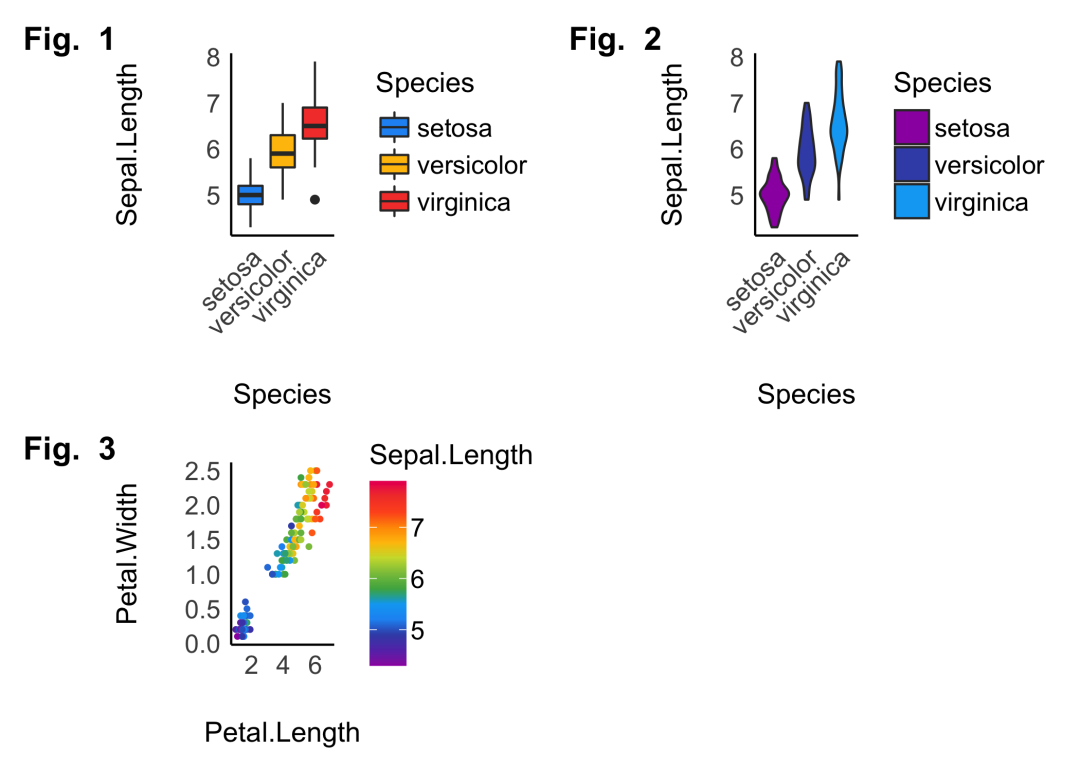
总结
以上就是小编关于R-see包的简单介绍,其中涉及到其他优秀包(如modelbased、performance等)会在后期开设专题和Python进行对比介绍。本期推文还是希望小伙伴们可以感受下R-see包的强大绘图能力,希望对大家有所帮助。
「完」
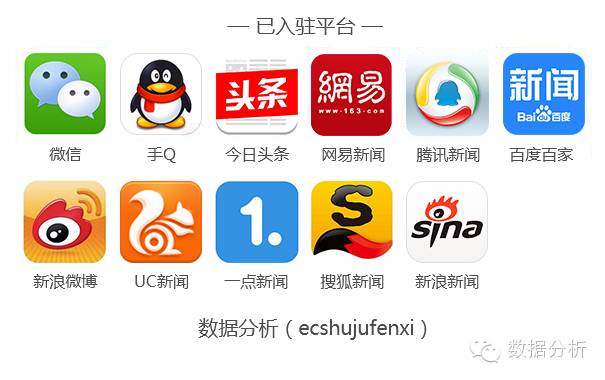
关注公众号:拾黑(shiheibook)了解更多
[广告]赞助链接:
四季很好,只要有你,文娱排行榜:https://www.yaopaiming.com/
让资讯触达的更精准有趣:https://www.0xu.cn/
 关注网络尖刀微信公众号
关注网络尖刀微信公众号随时掌握互联网精彩
- 1 去“三好”邻邦家做客 7904803
- 2 央行1万亿元大红包对普通人影响多大 7809092
- 3 中方代表驳斥美方:坚决拒绝 7711776
- 4 一文梳理这场国新办发布会 7619572
- 5 两国禁止武契奇乘机飞越领空 7524225
- 6 《刑警的日子》高亚麟被曝遭换脸 7425014
- 7 大打出手后 过去一夜印巴都克制了 7330821
- 8 拜登:特朗普太掉价了 7233308
- 9 巴总理激动拍桌:我们有实力有核力量 7140160
- 10 远隔万里的共同纪念 7040208

![马月 #网剧花戎# 小戎也期盼着魏家三小姐能够找到真正的幸福[爱你]再见啦魏凌月~](https://imgs.knowsafe.com:8087/img/aideep/2023/6/17/5940bfb89f25e0002504c2ee1ac6fa24.jpg?w=250)





 数据分析
数据分析







